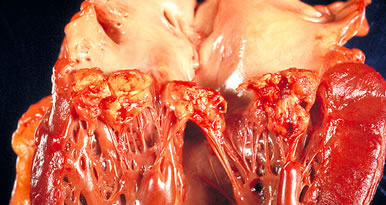Endocarditis
Endocarditis is the bacterial infection of the
endocardium or the thin membrane that lines the
chambers of the heart and the heart valves.

Subacute endocarditis affecting the mitral valve: destruction
of the
mitral valve fibrin due to Haemophilus parainfluenzae
bacterial infection.
Who Gets It?
People who are particularly susceptible to endocarditis infection
are those with pre-existing heart conditions and abnormalities,
such as:
- Congenital abnormal heart valves (such as mitral
valve prolapse)
- Septal defect (a small hole in the walls of the heart chambers)
- Artificial heart valves
- Coarctation of the aorta (narrowing of the aorta that causes
increased blood pressure)
Infection of the heart tissue occurs when bacteria is introduced
into the blood stream during:
- Dental cleanings or procedures
- Surgeries of the upper respiratory tract, colon, and urinary
tract
- Gynecological procedures
- Improper cleaning of injection site or using dirty needles
for intravenous or IV drug users
Because of this susceptibility to endocarditis, people with pre-existing
heart conditions should notify their doctor and dentists before
any medical procedures. Routine antibiotics such as erythromycin
and penicillin given the day before, the day
of, and the day after medical procedures can significantly reduce
the risk of getting endocarditis.
Symptoms of Endocarditis
The symptoms of endocarditis include:
- High fever or persistent low-grade fever
Fever occurs when the body's immune system fights off the bacterial
infection. In acute endocarditis, the onset is sudden and the
fever is high whereas in subacute form, a low-grade fever may
persist for days or weeks.
- Swelling and redness of the fingers and toes
- Fatigue or tiredness
- Night sweats
- Coughing
- Shortness of breath
- Joint pain and swelling
- Stomach pain
- Back pain
Endocarditis Diagnosis
Your doctor would look for the following signs in order to diagnose
endocarditis:
- Heart murmur
- Roth spots or tiny hemorrhages or bleeding at the back of
the eye
- Tiny bleeding under the fingernails and/or toenails (splinter
hemorrhage)
- Elevated levels of white blood cell
- Elevated sedimentation rate, a measure of infection or inflammation
- Presence of bacteria in blood culture
Treatment for Endocarditis
Treatment for this serious condition includes:
- Hospitalization
- Intravenous antibiotic therapy
- Oral antibiotic medications after hospital discharge
If damage occurs to the heart valve, or if the condition does
not improve after 10 days of antibiotics treatment, then a surgery
may be necessary to repair or replace the heart valve and correct
the heart defect.
Prognosis
Endocarditis is fatal if not treated, especially for those with
heart defects. However, if caught early and treated with antibiotics,
the prognosis is good.


